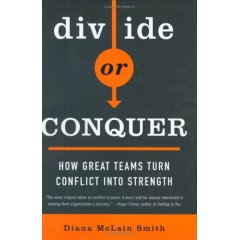|
|
|
Archive for June, 2008
Friday, June 13th, 2008
Post from Leadership Turn Image credit: Darwin Bell
This week our esteemed editor Kelly, AKA, TaxGirl, tossed us a Peter Maher quote instead of a picture for Fun Friday—“Running is a big question mark that’s there each and every day. It asks you, ‘Are you going to be a wimp or are you going to be strong today?'”
Then she asked, “What gets you going every day? What makes you a wimp?”
Well…OK…I’m not sure why wimpiness qualifies as a fun post, but I’m sure Kelly wouldn’t mislead us…would you, Kelly?
Jen over at Everyday Networker was first to post, but what she described as wimpiness I see as strength—the strength to consider her own mental health and extradite herself from a negative situation.
And that got me to thinking how often what one person calls wimping out may be another person’s greatest act of courage—or even their own. Likewise, what moves one leaves another cold.
That’s important knowledge, not information, but knowledge—maybe even wisdom—for every person responsible for leading/managing/motivating others.
What do you think?
Your comments—priceless
Don’t miss a post, subscribe via RSS or EMAIL
Posted in About Leadership, Change, Communication, Culture, Personal Development, What Do You Think? | 4 Comments »
Friday, June 13th, 2008
I write a lot about the importance of communications, written and verbal. Last summer I wrote about the difference just one letter can make to the meaning.
Rarely do I see typos in business headlines, so when a bulletin from Market Watch hit my email I was really surprised. Here it is.

My point? No matter how vigilant you are errors can happen. The important thing is to handle it with care and avoid the blame game. I’ll bet those responsible for proofing Market Watch bulletins were embarrassed enough without anybody saying a word.
How would you handle this situation?
Posted in Business info, Communication, Motivation | No Comments »
Thursday, June 12th, 2008
One of the great leadership discussions today centers around teaching, but most of the talk seems to come from politicians who are prolific with visions-sans-funding, senior academics from big name institutions who do research, and parents whose kids are caught in the maelstrom.
I told a friend of mine that I thought it would be interesting to hear from someone who teaches at a “no-name” public college and he said he knew just the guy—and he did.
When we first talked this prof told me that he had students who weren’t sure whether the Earth revolved around the Sun or the Sun around the Earth. (That knowledge did not give me a warm and fuzzy feeling about the future.)
So starting today and most Thursday’s I’ll be sharing posts with you from a very cool guy who has been teaching college for 20 years.
Some background: He did his undergraduate work in physics at Duke University and his graduate studies at Texas A&M University, where he switched emphasis to astrophysics. His primary research interests are in the fields of variable stars and the history of astronomy and space exploration; he’s authored almost 40 publications; these days he’s a Professor of Physics and Astronomy.
I’m calling him CandidProf, because the only way he can write really candid posts is to remain anonymous.
~~~~~~~~~~~~~~~~~~~~~~~~~~~~~~~~~
Handling Unprepared College Students (part 1)
Long ago, I decided that I wanted to be a scientist. So, I went to college and studied physics. Then, I went to graduate school, where I began my studies in ultra low temperature physics before shifting my emphasis to astronomy. Eventually, I became a professor of physics and astronomy. When I was in graduate school, I thought that being a professor would be doing research and then teaching. The teaching looked easy. After all, all you need to do is to explain things that you know about, right? But, it is not that simple.
Graduate school teaches you how to study your field and do research. It does not prepare you to teach. That is something that you have to learn on your own. Most colleges and universities have some teaching resources for faculty. But, striving for teaching excellence is still largely something left to individual faculty to figure out on their own.
Teaching is a big responsibility. You are expected to impart not just knowledge, but wisdom and skills. But, teaching is also an exercise in leadership, particularly in college. You do not simply download knowledge into student brains.
In pre-college education, a great deal of schooling is to teach basic knowledge. In college, you teach what to do with that knowledge and how to acquire more. In other words, you lead them to learning. So, a good college professor needs to have at least some leadership skills.
But leadership also requires followers. You can motivate some people to follow you. But unless someone is willing to be a follower, it is hard to lead them. Many new-to-college students do not realize that they need to follow. They expect you to do all of the work for them.
One of the tasks of a professor is to teach students to follow you and to learn. You can’t make them learn. You can’t put knowledge into their heads. You show them how to do it for themselves. You guide them and direct them. Then, they have to study. Unless they do some of the work, you can’t teach them.
Getting the students to that point is being a good college professor.
Unfortunately, some students have not the background to even be led.
Add your thoughts and be sure to join CandidProf next Thursday.
Your comments—priceless
Don’t miss a post, subscribe via RSS or EMAIL
Image credit: DAEllis
Posted in About Leadership, CandidProf, Followers, Leadership's Future | 11 Comments »
Thursday, June 12th, 2008
A couple of decades (give or take) ago Terry Dial, who eventually became vice chairman of Business Banking at Wells Fargo, told me that “People are 90% of our costs as well as the key to customer service and satisfaction. The only thing that should take priority over hiring a new employee is keeping a current one.”
Wise woman, Terry, and way ahead of her time.
Now comes another wise woman via Phil Gerbyshak’s interview with Sybil Stershic at Slacker Manager.
 Stershic’s written a book called Taking Care of the People Who matter most: A Guide to Employee Customer Care. The meaning of the title hits the nail on the head, “It’s based on the impact employees have on customers; namely, the way your employees feel is the way your customers will feel. And if your employees don’t feel valued, neither will your customers!” Stershic’s written a book called Taking Care of the People Who matter most: A Guide to Employee Customer Care. The meaning of the title hits the nail on the head, “It’s based on the impact employees have on customers; namely, the way your employees feel is the way your customers will feel. And if your employees don’t feel valued, neither will your customers!”
Is it true? Does it work? Tony Hsieh built Zappos on this principle.
Read the interview (Phil is always worth reading) and at the end you’ll find a great deal on the book.
What do you do to take care of your people?
Image credit: Windsor Media
Posted in Communication, Culture, Hiring, Motivation, Retention, Reviews & Recommendations | 2 Comments »
Wednesday, June 11th, 2008
Image credit: Luc Van Braekel

Check out my other WW: democracy and stuff
Posted in Wordless Wednesday | No Comments »
Wednesday, June 11th, 2008
Post from Leadership Turn Image credit: scatterkeir

Don’t miss my other WW: imagination takes flight
What other uses can you think of?
Your comments—priceless
Don’t miss a post, subscribe via RSS or EMAIL
Posted in Wordless Wednesday | 3 Comments »
Tuesday, June 10th, 2008
 When the economy slows, it’s easy to ignore retention factors because management kids itself into believing that replacing people is no big deal. When the economy slows, it’s easy to ignore retention factors because management kids itself into believing that replacing people is no big deal.
But slow as it’s happening, the times they are a’chnging.
At least here and there, in companies that really understand the importance of attracting and retaining scarce talent.
“To reduce “female brain drain,” global companies such as Ernst & Young, Goldman Sachs, Booz Allen Hamilton, Hewlett-Packard, Best Buy and dozens of others are increasingly offering a variety of flexible work options.”
Don’t get me wrong. These companies aren’t doing it out of the goodness of their corporate heart or caring social consciousness, they’re doing it because it makes financial sense, AKA, vested self-interest.
“Business analysts and executives say talent retention and the forces of demography are the chief reasons large, traditional companies accommodate the needs of female employees. Fifty-eight percent of college graduates are women, and nearly half of all professional and graduate degrees are earned by women…the number of women with graduate and professional degrees will grow by 16 percent over the next decade compared with an increase of only 1.3 percent among men.”
Many small companies are in the forefront, although they skip the language and the programs are more informal—that’s why they’re so often described as “being like a family.”
And although the work-life trend started with, and is being driven by women, the guys want it, too, as do the Millennials.
The economy will turn around—it always does; more Boomers will retire; talent will be scarcer and the companies that already know how to offer balance will have an enormous recruiting edge.
How does your company handle work-life issues?
Image credit: mjamesno
Posted in Business info, Culture, Hiring, Motivation, Retention | No Comments »
Tuesday, June 10th, 2008
Post from Leadership Turn Image credit: ~PATRISH~
By Wes Ball, author of The Alpha Factor – a revolutionary new look at what really creates market dominance and self-sustaining success. Read all of Wes’ posts here.
 When innovative thinkers in a company run up against restrictive management, their first thought is to “lead from the bottom.” When innovative thinkers in a company run up against restrictive management, their first thought is to “lead from the bottom.”
They try to create influence among other employees. They try to create a following among suppliers, distributors, salespeople, and anyone else they think they might influence. The result most typically is that the restrictive manager squashes them.
Interestingly, many top managers hope that these good ideas will filter up and be discovered. Sadly, they seldom, if ever, see such good thinking. They have no way of un-filtering the ideas that were filtered through the restrictive managers they placed between themselves and the real innovative thinkers at the lower levels of the company.
I’ve run into this in every large and many smaller organizations with whom I have worked. Top management desperately desires the ideas that are floating around at the lower levels of the company, but they never get to see them. I recall hearing a creative director at a large ad agency say that he regularly went into the junior copywriters’ offices and searched their trash cans – not to find problems, but rather to find good ideas that had been thrown away because they didn’t recognize their value. Too often, we see good ideas being “trashed” because managers don’t recognize their value.
In the meantime, top management is saying, “Where are all the good ideas we need?”
What about you?
Your comments—priceless
Don’t miss a post, subscribe via RSS or EMAIL
Posted in About Leadership, Culture, Leadership Skills, Wes Ball | 4 Comments »
Monday, June 9th, 2008
Image credit: stringbot
James Heskett is a Baker Foundation Professor, Emeritus at Harvard Business School and posts some of the most intriguing research questions I see at HBS Working Knowledge (FREE registration),
This week is no exception.
 “According to Gerald and Lindsay Zaltman, nearly all research techniques commonly used today probe humans only at their conscious level, though it is the subconscious level that really determines behavior. “According to Gerald and Lindsay Zaltman, nearly all research techniques commonly used today probe humans only at their conscious level, though it is the subconscious level that really determines behavior.
Online forum OPEN for comment until June 26. Jim Heskett asks: What is your organization—and what are you—doing to bring more deep thinking into work and life?”
I hope you’ll take a moment and add your thoughts to the dialog.
Posted in Business info, Leadership | 1 Comment »
Monday, June 9th, 2008
More than 30 years ago I noticed that people seemed to have two sides of their brain—personal and professional—and they rarely utilized the knowledge from one side to address situations on the other. One way that the two areas were kept separate was with language—different terms for what were essentially the same thing. This was especially true about their human interactions.
Many people attended “relationship workshops” on the weekend, but rarely thought to take what they learned to work on Monday because those were colleagues—not relationships.
But that was then and this is now.
 These days relationships are recognized as business lifeblood and everyone works to improve them, so Diana McLain Smith’s Divide or Conquer: How Great Teams Turn Conflict into Strength These days relationships are recognized as business lifeblood and everyone works to improve them, so Diana McLain Smith’s Divide or Conquer: How Great Teams Turn Conflict into Strength is right on the money. is right on the money.
Smith says that all teams “rise or fall on the strength of their relationships,” but instead of the typical discussion of team relationships, strengths, etc., she draws on her 25 years of experience and analyzes a number of high profile relationships to graphically illustrate her points.
She shows us why our belief that the problem is the other guy’s attitude/action and focusing on getting him to change boomerangs convincing the team that the source of the problem is actually us.
Smith says that what must change is how we interact, i.e., change the old patterns and create new ones, explaining how to build work relationships that are flexible and strong—the kind that can survive the tough challenges found in today’s global economy.
She takes you behind the media stories of relationships that made headlines, such as the recruitment and eventual meltdown of Steve Jobs and John Sculley, to illustrate how a broken relationship can cause severe damage not just to the people, but to the company and the brand.
Relationships happen, but great relationships take thought and effort. They’ll never be easy, but Divide or Conquer provides the tools and insights to make them easiER.
What did you think of the book?
Image credit: Wesman PR
Posted in About Leadership, Culture, management, Personal Development, Reviews & Recommendations | 7 Comments »
|
 Subscribe to
Subscribe to
MAPping Company Success
About Miki 
Clarify your exec summary, website, etc.
Have a quick question or just want to chat? Feel free to write or call me at 360.335.8054
The 12 Ingredients of a Fillable Req
CheatSheet for InterviewERS
CheatSheet for InterviewEEs™
Give your mind a rest. Here are 4 quick ways to get rid of kinks, break a logjam or juice your creativity!
Creative mousing
Bubblewrap!
Animal innovation
Brain teaser
The latest disaster is here at home; donate to the East Coast recovery efforts now!
Text REDCROSS to 90999 to make a $10 donation or call 00.733.2767. $10 really really does make a difference and you'll never miss it.
And always donate what you can whenever you can
The following accept cash and in-kind donations: Doctors Without Borders, UNICEF, Red Cross, World Food Program, Save the Children
*/
?>About Miki
About KG
Clarify your exec summary, website, marketing collateral, etc.
Have a question or just want to chat @ no cost? Feel free to write
Download useful assistance now.
Entrepreneurs face difficulties that are hard for most people to imagine, let alone understand. You can find anonymous help and connections that do understand at 7 cups of tea.
Crises never end.
$10 really does make a difference and you’ll never miss it,
while $10 a month has exponential power.
Always donate what you can whenever you can.
The following accept cash and in-kind donations:
|







 Stershic’s written a book called
Stershic’s written a book called 

 When the economy slows, it’s easy to ignore retention factors because management kids itself into believing that replacing people is no big deal.
When the economy slows, it’s easy to ignore retention factors because management kids itself into believing that replacing people is no big deal. When innovative thinkers in a company run up against restrictive management, their first thought is to “lead from the bottom.”
When innovative thinkers in a company run up against restrictive management, their first thought is to “lead from the bottom.” “According to Gerald and Lindsay Zaltman, nearly all research techniques commonly used today probe humans only at their conscious level, though it is the subconscious level that really determines behavior.
“According to Gerald and Lindsay Zaltman, nearly all research techniques commonly used today probe humans only at their conscious level, though it is the subconscious level that really determines behavior. These days relationships are recognized as business lifeblood and everyone works to improve them, so Diana McLain Smith’s
These days relationships are recognized as business lifeblood and everyone works to improve them, so Diana McLain Smith’s 
